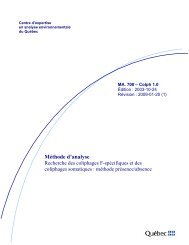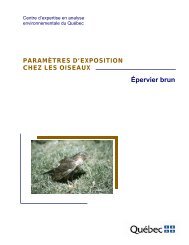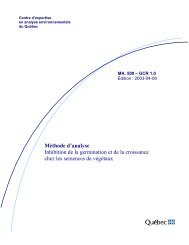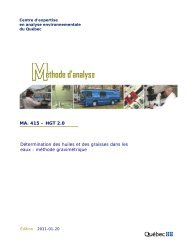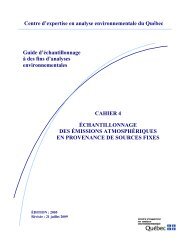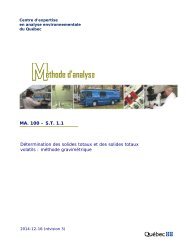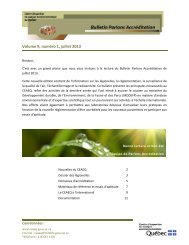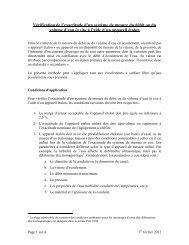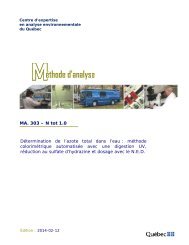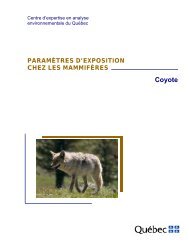- Page 1: Centre d’expertise en analyse env
- Page 5: FOREWORDThis Sampling Guide for Env
- Page 8 and 9: 4.4. Area/velocity method..........
- Page 10 and 11: LIST OF ILLUSTRATIONSFigure 1 - Wei
- Page 13 and 14: 1. GENERAL1.1. Definition of flowra
- Page 15 and 16: Note: If effluents have different d
- Page 17 and 18: This equation shows that water dept
- Page 19 and 20: Sizes vary according to the type an
- Page 21: FIGURE 1 - WEIR COMPONENTSFlow is d
- Page 25 and 26: FIGURE 2 - PALMER-BOWLUS - FLUME CH
- Page 27 and 28: TABLE 1 - DIMENSIONS FOR PALMER-BOW
- Page 29 and 30: 1.12. Choosing a measurement method
- Page 31 and 32: FIGURE 4 - FLUME - FLUME AND FLOW C
- Page 33 and 34: TABLE 3 - CHART FOR COMPARING THE M
- Page 35 and 36: TABLE 4 - DIMENSIONS FOR STILLING W
- Page 37 and 38: 2. DESCRIPTION OF FLUMESThe section
- Page 39 and 40: 2.1.2. Operating principleA Parshal
- Page 41 and 42: TABLE 5 - PARSHALL FLUME - STANDARD
- Page 43 and 44: TABLE 6 - PARSHALL FLUME - RECOMMEN
- Page 45 and 46: 2.1.7. PrecisionThe margin for erro
- Page 47 and 48: channel at maximum flow (H c ), bef
- Page 49 and 50: FIGURE 8 - PARSHALL FLUME - JUNCTIO
- Page 51 and 52: FIGURE 9 - PARSHALL FLUME - EFFECTS
- Page 53 and 54: 2.1.12. Discharge equation in a sub
- Page 55 and 56: FIGURE 11 - LOSS OF HEAD - PARSHALL
- Page 57 and 58: To monitor the total rise, follow t
- Page 59 and 60: A Palmer-Bowlus flume, as experimen
- Page 61 and 62: FIGURE 13 - SHAPE OF A PALMER-BOWLU
- Page 63 and 64: TABLE 10 - PALMER-BOWLUS FLUME - ST
- Page 65 and 66: Because some manufacturers do not a
- Page 67 and 68: −use of the depth/flow table2.2.1
- Page 69 and 70: For temporary systems, a simple ver
- Page 71 and 72: Q is the flowrate in liters or US g
- Page 73 and 74:
FIGURE 15 - SHAPE OF LEOPOLD-LAGCO
- Page 75 and 76:
2.3.7. Measurement capacity of a fl
- Page 77 and 78:
2.3.11. Installation specifications
- Page 79 and 80:
2.4.2. Operating principleCutthroat
- Page 81 and 82:
TABLE 14 - CUTTHROAT FLUME - STANDA
- Page 83 and 84:
TABLE 15 - CUTTHROAT FLUME - RECOMM
- Page 85 and 86:
TABLE 16 - CUTTHROAT FLUME - VALUES
- Page 87 and 88:
TABLE 18 - CUTTHROAT FLUME - DISCHA
- Page 89 and 90:
Since a number of other cutthroat f
- Page 91 and 92:
where:Q is the flowrate in cubic me
- Page 93 and 94:
Example: To measure a 0.6 m 3 (21 C
- Page 95 and 96:
It consists of two sections: approa
- Page 97 and 98:
FIGURE 18 - H FLUME - PHYSICAL CHAR
- Page 99 and 100:
Although this type of flume can be
- Page 101 and 102:
TABLE 21 - H FLUME - STANDARD DIMEN
- Page 103 and 104:
TABLE 23 - H FLUME - RECOMMENDED MI
- Page 105 and 106:
CoefficientsandexponentsTABLE 24 -
- Page 107 and 108:
−erosion at the outlet of the flu
- Page 109 and 110:
2.5.13. Flume modificationTo obtain
- Page 111 and 112:
Example:For a rectangular weir wher
- Page 113 and 114:
−−−−−−−the presence o
- Page 115 and 116:
TABLE 25 - WEIR CALIBRATION - VOLUM
- Page 117 and 118:
FIGURE 20 - RECTANGULAR WEIR WITHOU
- Page 119 and 120:
TABLE 26 - RECTANGULAR WEIR WITHOUT
- Page 121 and 122:
Inadequate approach velocityThe app
- Page 123 and 124:
FIGURE 21 - RECTANGULAR WEIR WITH C
- Page 125 and 126:
The Kindsvater-Carter equation take
- Page 127 and 128:
3.3.5. PrecisionIn free flow condit
- Page 129 and 130:
TABLE 28 - RECTANGULAR WEIR WITH CO
- Page 131 and 132:
FIGURE 22 - TRAPEZOIDAL WEIR (CIPOL
- Page 133 and 134:
TABLE 29 - TRAPEZOIDAL WEIR (CIPOLL
- Page 135 and 136:
Length of contractionsIf side contr
- Page 137 and 138:
In addition to the information prov
- Page 139 and 140:
The discharge equation resulting fr
- Page 141 and 142:
3.6. Combined weirTo obtain a preci
- Page 143 and 144:
In addition to the information prov
- Page 145 and 146:
3.6.5. PrecisionIn free flow condit
- Page 147 and 148:
FIGURE 25 -COMPOUND WEIR - PHYSICAL
- Page 149 and 150:
TABLE 32 - COMPOUND WEIR - MEASUREM
- Page 151 and 152:
4.1.1.2 Characteristics of tracersT
- Page 153 and 154:
S gis the specific weight of the tr
- Page 155 and 156:
4.1.2.1.4 Disadvantages of the meth
- Page 157 and 158:
When selecting a sampling point, it
- Page 159 and 160:
4.1.2.2.8 Detection and measurement
- Page 161 and 162:
Dyes are well suited to flow measur
- Page 163 and 164:
4.1.2.3.8 Detection and measurement
- Page 165 and 166:
4.1.2.4.3 Preparation of radioactiv
- Page 167 and 168:
4.1.2.4.9 Preliminary testsBefore c
- Page 169 and 170:
4.1.3.1.3 Advantages of the method
- Page 171 and 172:
Testing procedures are as follows:T
- Page 173 and 174:
Use the following formula to determ
- Page 175 and 176:
The discharge equation is therefore
- Page 177 and 178:
• Choosing a tracerExamine the di
- Page 179 and 180:
Sampling must be carried out during
- Page 181 and 182:
−−contamination of sampling con
- Page 183 and 184:
Instantaneous injections1 2 3 4 5nP
- Page 185 and 186:
tracer is lost due to splashing, by
- Page 187 and 188:
The concentration of tracers is usu
- Page 189 and 190:
4.1.3.3.7 Causes of errorThe princi
- Page 191 and 192:
4.2.4. DisadvantagesThe principal d
- Page 193 and 194:
−If the dimensions cannot be meas
- Page 195 and 196:
4.3.7. DisadvantagesFlow measuremen
- Page 197 and 198:
4.3.8.2 Calculation of pumping time
- Page 199 and 200:
4.3.8.4 Number of testsWhen a pumpi
- Page 201 and 202:
−−−−−requires a number of
- Page 203 and 204:
4.4.9. Flow areaMeasurement of the
- Page 205 and 206:
Velocity measurements should be tak
- Page 207 and 208:
considering only the source of erro
- Page 209 and 210:
There are also other causes of bias
- Page 211 and 212:
12. GRANT, D. M., ISCO Open Channel
- Page 213:
36. INTERNATIONAL STANDARD ORGANISA
- Page 216 and 217:
CHANDRA, U., Aoki, P. E., Ramos e S
- Page 218 and 219:
HAMMER, Mark J., Water and Waste-Wa
- Page 220 and 221:
Resources Instrumentation, June 4-6
- Page 222 and 223:
REPLOGLE, John A., Meyers, Lloyd E.
- Page 224 and 225:
TRIESTE, Douglas J., Evaluation of



